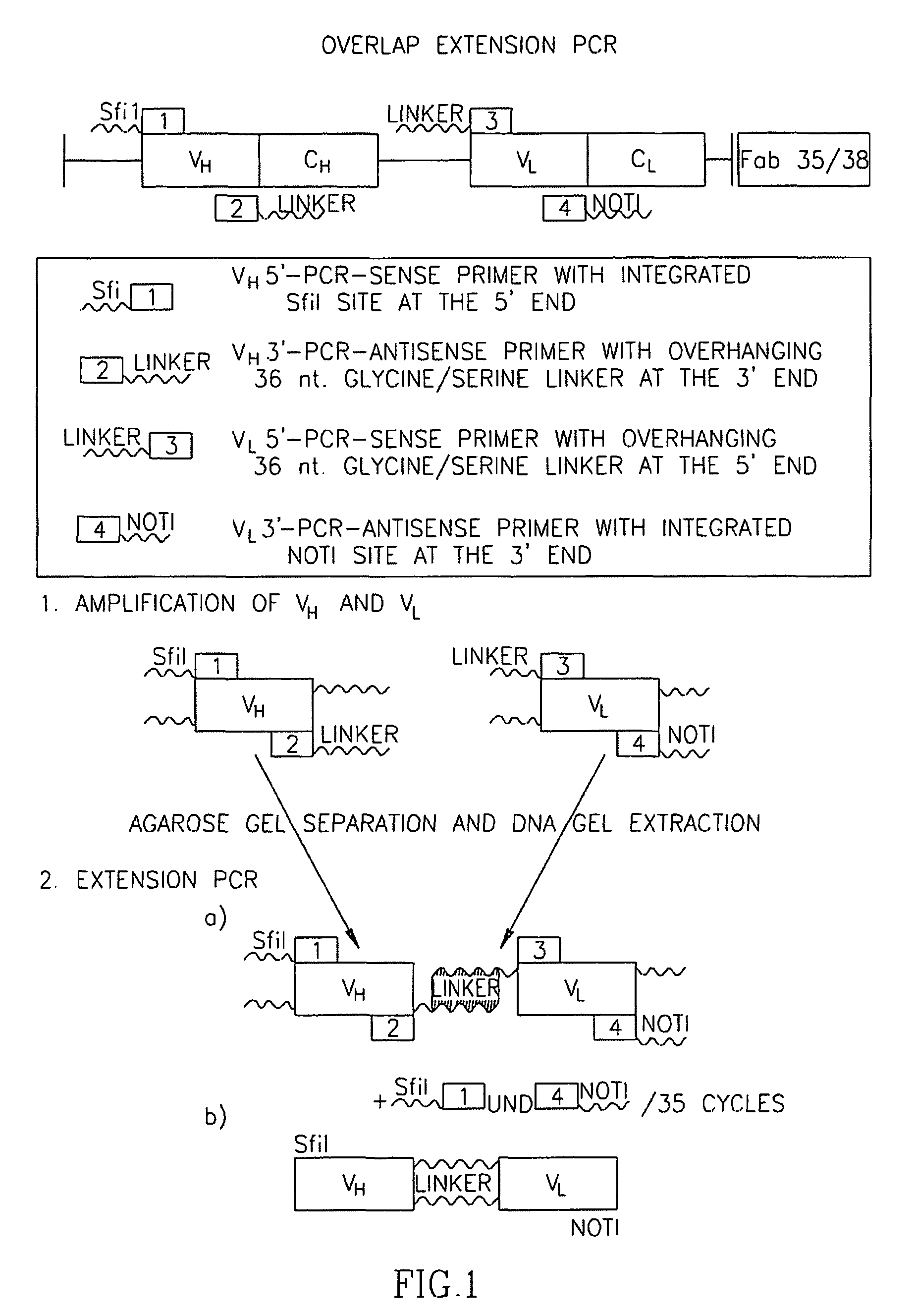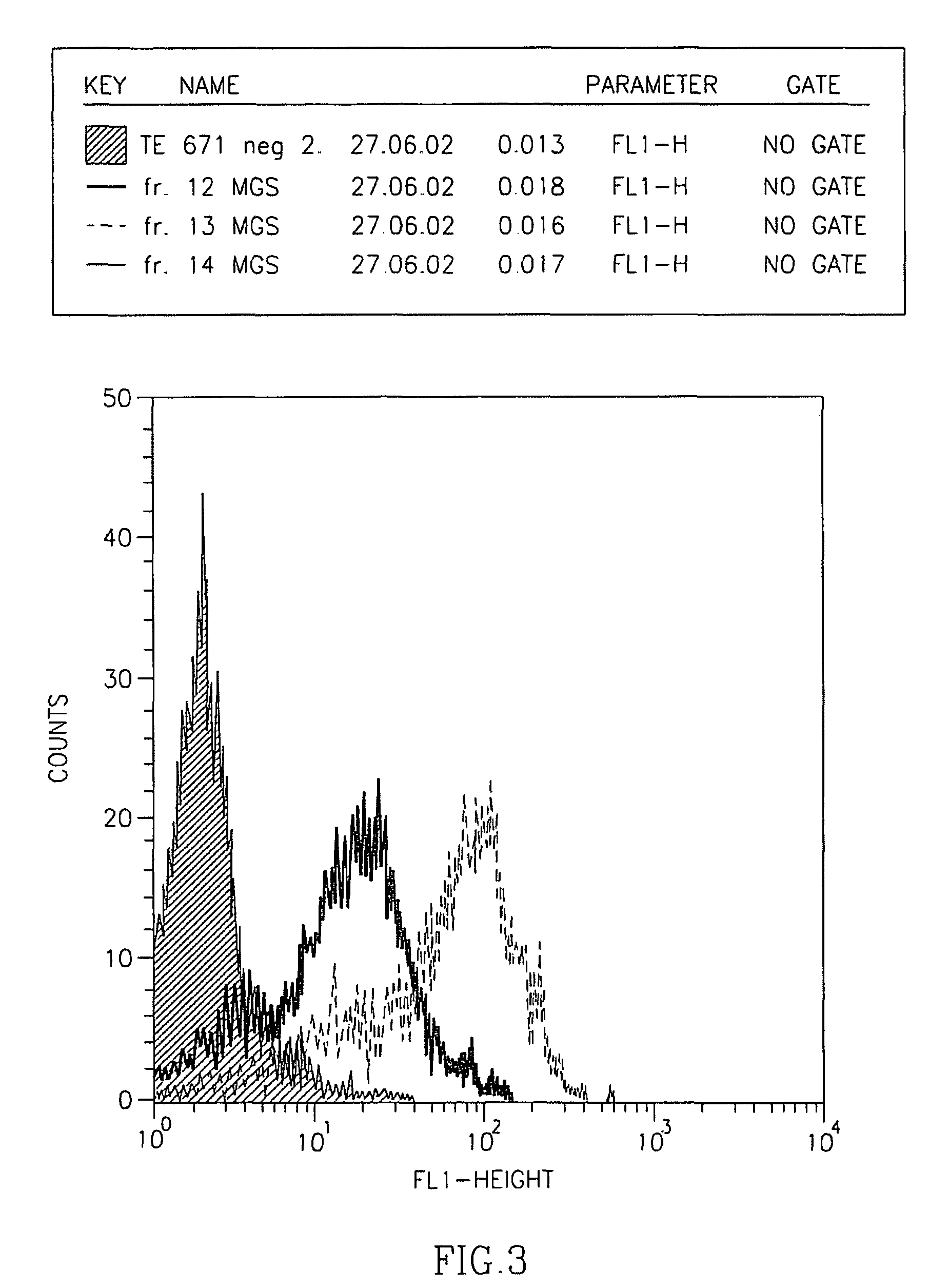Immunotoxin derived from a recombinant human autoantibody and method of using thereof
a human autoantibody and immunotherapy technology, applied in the direction of antibody ingredients, carrier-bound/immobilised peptides, non-active ingredients of pharmaceuticals, etc., can solve the problems of poor prognosis of soft tissue tumours in children, 5-year survival rates of 5-20%, and immunotherapies or other (e.g. genetic) specific targeting strategies have not yet been applied, so as to prevent myasthenia gravis and prevent arthrogryposis
- Summary
- Abstract
- Description
- Claims
- Application Information
AI Technical Summary
Benefits of technology
Problems solved by technology
Method used
Image
Examples
example 1
An IT Targeting the Main Immunogenic Region (MIR) of the AChR α-Subunit Kills RMS Cells In Vitro
[0115]In a first step we generated an ETA-containing IT based on a recombinant single chain Fv fragment that had been derived from the well characterized rat monoclonal antibody mAb195 against the main immunogenic region (MIR) of the human AChR α-subunit. This model IT (scFv-195-ETA) specifically bound to several RMS cell lines as revealed by FACS (not shown). Binding of scFv-195-ETA to TE671 RMS cells could be competed using unlabeled scFv-195 (not shown). In addition, scFv-195-ETA killed the RMS cell lines TE671, FLOH-1 and RD in a dose-dependant manner, while non-RMS epithelial, hematopoietic and neurogenic cell lines (A431; U937; IMR32, respectively) without muscular AChR expression were not killed (FIG. 2). These experiments were considered as “proof-of-principle” that specific targeting of the AChR by an IT can kill AChR-positive RMS cells. Since the α-subunit is shared by RMS cells...
example 2
Synthesis of an IT Targeting the γ-Subunit of the Human Fetal AChR In Vitro
[0116]Since the fetal AChR, specified by the γ-subunit, is virtually absent in non-neoplastic innervated skeletal muscle but expressed in most RMS, we generated an ETA-based IT with specificity for the AChR γ-subunit. Synthesis started from two recombinant human Fab fragments (Fab35 and Fab38) that were derived from a combinatorial cDNA library derived from the thymus of a seropositive MG patient with high titers of anti-AChR γ-subunit antibodies. Although cloning of the two Fab fragment cDNAa into the ETA-vector resulted in constructs that were in frame as revealed by sequencing, they were inefficiently translated in transformed E. coli BL21DE3, resulting in several abnormal protein fragments of 70-80 kd instead of the expected 120 kd full-lenghth IT (not shown). Therefore, we used the Fab35 and Fab38 cDNAs to produced single-chain Fv (scFv) fragments by overlap extension PCR (FIG. 1). VH and VL fragments we...
example 3
An AChR γ-Subunit-Targeting Immunotoxin Delays Tumour Development in a Mouse RMS Transplantation Model
[0119]35 scFvVL-VH-ETA was further investigated for its in vivo killing capacity using RD RMS cells as targets in a RMS transplantation mouse model. Toxicity tests revealed that intravenous injection of 10 μg IT per mouse had no apparent advers effect on the mice tested (n=10) in terms of mobility, weight development, and survival (up to 60 days). Therefore, this dose of IT was co-injected with RD cells (107 per mouse) (n=10) intravenously. Saline injections served as negative controls (n=4). Twice daily injections of 10 μg IT per mouse were repeated up to day 10. Tumour development was monitored by daily inspection and palpation. As shown in FIG. 5, 100% of mock injected mice exhibited palpable tumours day 7 of the experiment, and clearely visible subcutaneous tumours by day 10 (volume: 59+ / −9mm3). By contrast, no or minimal tumours were detectable in IT-injected mice by day 4 and ...
PUM
| Property | Measurement | Unit |
|---|---|---|
| tumour volumes | aaaaa | aaaaa |
| flow rate | aaaaa | aaaaa |
| pH | aaaaa | aaaaa |
Abstract
Description
Claims
Application Information
 Login to View More
Login to View More - R&D
- Intellectual Property
- Life Sciences
- Materials
- Tech Scout
- Unparalleled Data Quality
- Higher Quality Content
- 60% Fewer Hallucinations
Browse by: Latest US Patents, China's latest patents, Technical Efficacy Thesaurus, Application Domain, Technology Topic, Popular Technical Reports.
© 2025 PatSnap. All rights reserved.Legal|Privacy policy|Modern Slavery Act Transparency Statement|Sitemap|About US| Contact US: help@patsnap.com



